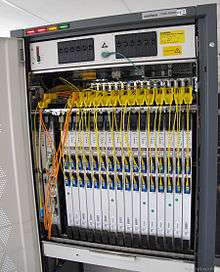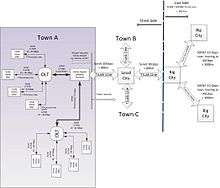Optical line termination
An optical line termination (OLT), also called an optical line terminal, is a device which serves as the service provider endpoint of a passive optical network. It provides two main functions:
- to perform conversion between the electrical signals used by the service provider's equipment and the fiber optic signals used by the passive optical network.
- to coordinate the multiplexing between the conversion devices on the other end of that network (called either optical network terminals or optical network units).

An Alcatel-Lucent OLT used by the French operator CityPlay
The diagram below depicts an OLT within a fiber-optic network.

OLT & ONU in Fiber Optic Network
Features
OLTs include the following features:
- A downstream frame processing means for receiving and churning an asynchronous transfer mode cell to generate a downstream frame, and converting a parallel data of the downstream frame into a serial data thereof.
- A wavelength division multiplexing means for performing an electro/optical conversion of the serial data of the downstream frame and performing a wavelength division multiplexing thereof.
- An upstream frame processing means for extracting data from the wavelength division multiplexing means, searching an overhead field, delineating a slot boundary, and processing a physical layer operations administration and maintenance (PLOAM) cell and a divided slot separately.
- A control signal generation means for performing a media access control (MAC) protocol and generating variables and timing signals used for the downstream frame processing means and the upstream frame processing means.
- A control means for controlling the downstream frame processing means and the upstream frame processing means by using the variables and the timing signals from the control signal generation means.
gollark: Yep!
gollark: Well, more like "stick backdoors in your stuff OR ELSE".
gollark: Australia has passed their utterly moronic anti-encryption law!
gollark: .
gollark: Since, you know, if your expected readers can decode it, so can others
This article is issued from Wikipedia. The text is licensed under Creative Commons - Attribution - Sharealike. Additional terms may apply for the media files.